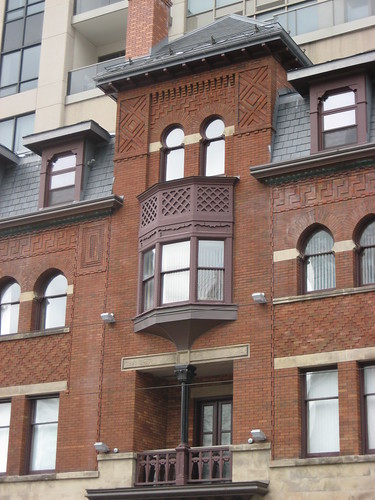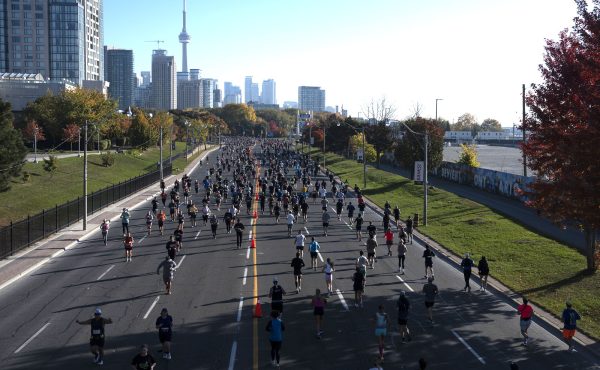

Given the winter we’ve been having it would seem impossible to think of Toronto as being in any way exotic, much less to draw comparisons between our city and one in Morocco or the Middle East. That is, until you encounter a work of exotic revival architecture.
Like many cities within the sphere of Anglo-American influence, Victorian Toronto had a small love affair what they saw as the “exotic” architectural forms of Islam. Bearing few children, this affair left only small vestiges behind. These buildings, often described simply as “Moorish,” draw their inspiration from north Africa, Turkey, and the Middle East. The few examples that survive today are easy to miss, which is why encountering one on a snowy winter day is all the more surprising — looking at home yet somewhat foreign under a thick blanket of snow.
The Moorish Revival style was one of many revival styles to spring up during the nineteenth and early twentieth centuries. An offshoot of Victorian Romanticism that evolved into an interest in all things “oriental,” this fascination manifested itself into vaguely Islamic forms being applied to all manner of buildings. The style made its way to Canada via England and the United States, where it had already been employed since the early nineteenth century.
In central Europe, Jews began to use the style for synagogues and consequently spread it all over the world. Toronto’s oldest Jewish congregation used Moorish forms when they built Holy Blossom Temple on Bond Street in 1897. Now a Greek Orthodox church, the building has been altered to appear more like a standard Greek church, most notably in the altered shape of the domes. Compare the two images here and here.
Most commonly employed for use in “Moorish” or “Turkish” smoking rooms, Toronto has a beautiful and accessible interior example of this at the former Massey mansion on Jarvis Street (now the Keg Mansion). Massey Hall, built in 1894, relied heavily on the Moorish style for its interior decorations. This stands in stark contrast to its more neo-classical exterior. Now trimmed down, the interior still retains some of its earlier Moorish flare. Nearby on Church Street, the former Athenaeum Club has all but vanished — save for its faà§ade, now incorporated into a condo. The Moorish inspiration is evident in the arches and intricate brickwork of its surviving faà§ade.
Unfortunately Toronto has lost two of its most interesting examples. The John Miller house, formerly on Murray Street, looked to Morocco for inspiration and would have been a one-of-a-kind eccentricity when it was built in 1898. The Bethany Chapel located on University Avenue is almost entirely forgotten, lasting only briefly from 1893 to 1910. This structure housed a religious sect that didn’t feel traditional church architectural forms could express their religious views and relied instead on the Moorish style to evoke images of the Holy Land.
With an increasing Muslim population in Toronto, these forms are enjoying something of a revival, this time for religious structures conveying personal references for the users own faith and heritage rather than as exotic and colonial decorations. Like their nineteenth-century predecessors, they look both at home and also foreign in the midst of a snowy Toronto winter.
Editor’s Note: This post is an ongoing column exploring various architectural styles in and around Toronto. Spacing writer and heritage architecture consultant Thomas Wicks will look into the history of that style, the people behind it, and where in Toronto examples can be found.
Photo of Athenaeum Club on Church Street by author.




12 comments
With an increasing Muslim population in Toronto, these forms are enjoying something of a revival, this time for religious structures conveying personal references for the users own faith and heritage rather than as exotic and colonial decorations.
I’m no architectural historian, but I’m not sure the Nugget Mosque exemplifies Moorish architecture, nor that Moorish architecture reflects the heritage of its South Asian (or, for that matter, Middle Eastern) Muslims.
Most Maghrebi immigrants to Canada settle in Montreal, not Toronto. In Toronto — perhaps ironically, in light of the Wikipedia- and Toronto-centric parts of the entry — one of the few very recent and, in Thomas Wicks’ paradigm, “authentic” local examples of Moorish-style architecture is, in fact, a synagogue.
Thanks for pointing out that the example is in fact a synagogue not a mosque. That then would relate it to the same use of the style as the Original Holy Blossom temple on Bond street. Synogugues widely used the style as it referenced jewish history in spain, where much of this architecture can be found as it was brought there by the muslim population centuries ago.
I heart Marrakesh. Both are fantastic cities to walk around and get lost in…
However Toronto doesn’t have anything close to the Djemaa el Fna sqaure. Or do we?
Jam
That then would relate it to the same use of the style as the Original Holy Blossom temple on Bond street.
It would do that, too (hence the perhaps ironically), but the more relevant match here is your suggestion that these forms are enjoying something of a revival, this time for religious structures conveying personal references for the users own faith and heritage rather than as exotic and colonial decorations. To wit, the form has enjoyed at least one own-faith-and-heritage revival we can point to, and here it is. (Again, I don’t see the Nugget Mosque being in the Moorish style at all — am I missing something, or is “Moorish style” being used as shorthand for “Islamic architecture”?)
You see, when you say that there is an increasing Muslim population in Toronto and that therefore these forms are enjoying something of a revival, this time for religious structures conveying personal references for the users own faith and heritage rather than as exotic and colonial decorations, I just don’t see it. There may be an increasing Muslim population in Toronto, but it is not (much) a Maghrebi one. It does not make sense to lump all Muslims together into an indistinguishable mass — not more, for that matter, than it makes sense to stereotype the Maghreb as ethnically or religiously homogeneous. Your piece does both.
Ironic that the building in the featured photo, the Athenaeum Club, fell victim to facade-ism and is now a mere veneer spliced onto the front of a generic condo tower named “Jazz”, if memory serves.
It was a fantastic space which lastly housed a dance club as well as artists and other assorted bohos before being demolished. Mortgage-holding, cubicle-toiling condo-dwellers now inhabit its usurper.
hunter> The facade-ism criticism is a valid debate — I like that a bit is kept, but all the “good parts” — the mystery, the nooks, the possibility of discovery — that make old buildings wonderful are gone.
I went to that club before the Jazz went up — had a huge main room and, if I recall, a great balcony that circled it.
However, I don’t get the jab at condo dwellers (here, elsewhere, in general). Why the “cubicle” judgement? I dont’ know anything about most condo owners, and I wouldn’t want to presume. Condo’s are the only places middle and even working class people can afford to buy in Toronto, and their proliferation is the only way we’ll fit in all the people who are coming.
Figured that would get a rise out of you, Shawn.
These new condos are just vertically-stacked burbs. They really are changing the character of the city. And if the trend continues….
Nor are they “the only way”. Mid-rise development is more conducive to good neighbourhoods, see: St. Lawrence Market area. There is enough open land and mediocre existing structures to build over. Condo developers should not be allowed to run roughshod just by agreeing to save a few bricks.
Not a rise, just curious thoughts related to a larger investigation of why TO has a fear of heights.
It’s ok not to like highrises personally. We all like what we like and dislike accordingly. Taste cannot be legistlated.
But,
1> I don’t understand why condo dwellers are often characterized poorly, often in sneering comments to “those kinds of people.” What is this based on? It seems downright snobby at times.
2>How are condo’s stacked burbs? They are exquisitely urban, letting more people enjoy downtown urban life. Height in appropriate places, like the Yonge Street Corridor, do not make mid-rise any less desirable when they are appropriate, or signal a destruction of Toronto’s fabled neighbhourhoods. Height can also be very urban, when done right. There are some atrocious examples though that often get the attention.
3> The character of the city has always been changing. That’s the nature of cities. Most characterizations of cities that are called “traditional” or such are just snapshots that don’t capture the every-moving-change. If anything, constant change and evolution is the character of Toronto.
(Note, these are general comments, not necessarily directed at you, hunter, though you provided a jumping off point)
Actually, I don’t find much of a fatal tipping-point in urban effect between the St. Lawrence development’s mid-rise and Jazz’s somewhat-higher-rise–in fact, Jazz is more unlike the glass shaft of Spire down the street than it’s unlike St. Lawrence.
Which isn’t a defense of Jazz’s architecture, facadism, or “condo-ness”; but it’s worth considering that it’d be no less so-called banal/suburban were it St. Lawrence-style midrise. The facadism would still be there, as would the “condo demographics”, real or imagined…
My main point is what has been lost/destroyed, not the relative merits of mid or hi-rise condos.
Well, a lot of that is certainly lamentable — but it would have gone for mid or high rise — or sometimes it’s even gone for parking lot.
nevermind